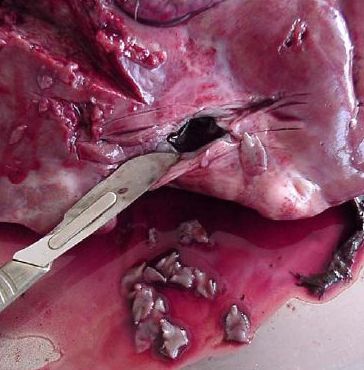-
 Vitamin B9
Vitamin B9
-
 Anabolism
Anabolism
-
 Auricles
Auricles
-
 Herbivore
Herbivore
-
 Tau neutrino
Tau neutrino
-
 Opposition
Opposition
-
 Proteolysis
Proteolysis
-
 Compatibility
Compatibility
-
 Minamata Bay Disaster
Minamata Bay Disaster
-
 Herschel satellite
Herschel satellite
-
 Terrestrial planet
Terrestrial planet
-
 Fentes alpines
Fentes alpines
-
 Converting enzyme inhibitor
Converting enzyme inhibitor
-
 Colour rendering index
Colour rendering index
-
 Ligase
Ligase
-
 Lipid
Lipid
-
 Metamorphic rock
Metamorphic rock
-
 Salt
Salt
-
 Microfluidics
Microfluidics
-
 Firmicute
Firmicute
-
 Borage
Borage
-
 Mithridatism
Mithridatism
-
 Wilson Cycle
Wilson Cycle
-
 GDP
GDP
-
 Conductance
Conductance
-
 In vitro fertilisation
In vitro fertilisation
-
 Genus
Genus
-
 Half-life
Half-life
-
 Spokes
Spokes
-
 WAN
WAN
Liver fluke
The large adult fluke (Fasciola hepatica) is a common parasite in cattle and sheep, which implants itself in the bile ducts and lays its eggs which are excreted in faeces.
The eggs then rupture in a damp environment (pastures) and the larvae, known as miracidia, grow rapidly, reproducing through an asexual mechanism within small aquatic molluscs, limnaea. The new larvae are called cercariae. Each miracidium can produce 1,000 to 10,000 cercariae.
These take on a swimming form and, in autumn, bind to various plant supports by positive phototropism. This infesting form is known as the metacercariae.
Herbivores are infected by eating infested plants. The metacercariae rupture in the gastro-intestinal tract and the small flukes grow whilst they move along the gastro-intestinal mucosa, then cross it arriving in the liver and entering Glisson's capsule before reaching the bile ducts where the mature flukes become established and re-start the cycle.
The flukes can also affect other anatomical regions including: the lungs, mesentery, stomach, brain, kidneys and thyroid, causing various serious diseases.
Human beings can be infested by eating dandelions, cress, or other wild salad leaves.
Symptomatology
The disease is asymptomatic in approximately 25% of cases.
Otherwise, various features are commonly seen including weakness, accompanied by weight loss, erratic temperature with peaks of 39°C, and pain in the right hypochondrium or epigastric region.
Gastro-intestinal symptoms include abdominal pain, nausea, and vomiting, with alternating diarrhoea and constipation.
Immuno-allergic features include joint and muscle pain, flitting oedema and urticaria.
These symptoms may add to each other or they may be present in part.
 Flukes implanted in a deer liver Source: AFFSA.
Flukes implanted in a deer liver Source: AFFSA.
Latest
Fill out my online form.



